This post may contain affiliate links, from which we earn an income. Click here to read our affiliate policy.
What to pack & wear for winter in Europe
Travelling to Europe in winter comes with two major challenges: packing light and staying warm. It’s all about striking that balance between looking put-together and not freezing while you’re dashing through airports, strolling through snowy old towns, or cramming onto a tram in Prague in minus five.
Whether you’re heading to Scandinavia in January or catching the last of the sun in southern Spain in December, a bit of seasonal planning goes a long way.
This post breaks down the weather and fashion must-knows for winter in Europe: first by month, then by region. You’ll find capsule wardrobe ideas, cold weather packing tips, and the kinds of winter travel outfits that actually work for sightseeing, dinners, and transit days. Plus, we’ll talk about that holy grail combo: a comfy airport outfit that still looks like you made an effort.

The Ultimate Winter Airport Outfit Formula You’ll Love Wearing
Cold weather airport style is a delicate art: you want to stay warm getting to the terminal, comfortable during the flight, and still look like you’ve got your life together when you arrive in Europe with jet lag and a face full of dry cabin air. A winter airport outfit needs to layer well, be easy to move in, and transition smoothly from check-in to city streets.
Here’s the go-to winter airport outfit formula that works every time:
Base layer: Start with a soft, breathable thermal or long-sleeve tee. Merino wool is ideal, lightweight, naturally temperature regulating, and doesn’t smell after a long-haul flight. If you run cold, go for a Uniqlo Heattech top or cotton base you won’t overheat once inside.
Bottom half: Go for structure with stretch. Think soft travel pants (pull-on or elasticated waist styles with a straight leg), ribbed knit trousers, or heavyweight leggings. They won’t dig in mid-flight but still look tailored enough to walk off the plane into a European café without looking like you’ve just come from baggage reclaim.
Mid-layer: A relaxed hoodie, quarter-zip fleece, or oversized knit gives you warmth and volume without bulk. Bonus points if it has a pocket for your passport.
Outerwear: Wear your bulkiest coat. That’s either your wool overcoat (if you’re headed to Western Europe or Southern cities) or a padded parka (for Scandinavia or Eastern Europe). Choose something that’s warm, windproof, and ideally has inside pockets for boarding passes and lip balm.
Shoes: Ankle boots with side zips or high-top trainers that are easy to take off at security. Make sure they’re waterproof if you’re landing somewhere snowy. And always wear thick socks on the plane. You’ll thank yourself when the cabin temp drops to “glorified freezer.”
Accessories: A big scarf that doubles as a blanket, a beanie or baseball cap to hide plane hair, and a belt bag or crossbody for your essentials. Don’t forget wireless headphones and a refillable water bottle.
You’ll look pulled together and stay warm, and still be comfy enough to sleep through a three-hour delay.
Outfits for December in Europe
Western Europe
Paris, Brussels, Amsterdam, and nearby cities are cold, damp, and often windy in December. Temperatures sit between 2–8°C (36–46°F), with drizzle more likely than snow, and daylight fading before 5pm. Layering is your best friend here: a thermal base, sweater, warm overcoat, and lined boots will take you from cathedral tours to cozy dinners.
For sightseeing outfit winter style, go with thermal leggings or travel pants for women, a wool jumper, and a belted coat with a thick scarf. For your airport outfit winter look, wear soft knit trousers, layered tops, and a coat you can use on the trip to save luggage space.
What to Pack for Western Europe in December:

Southern Europe
Southern Spain, Southern France, the Italian coast and islands tend to be milder, with temperatures ranging from 10–17°C (50–62°F). You can still wear winter fashion here, but make it lighter: think stylish quilted jackets, mid-weight knits, and breathable layers you can peel off on a sunny afternoon.
Outfits for southern Europe in December still call for long sleeves, but you can skip snow boots and go for leather ankle boots or clean sneakers. For travel wear, a chic airport outfit might include straight-leg jeans, a long-sleeve tee, and a smart wool coat or trench you can wear throughout the trip.
What to Pack for Southern Europe in December:

Eastern Europe
Expect snow, frosty mornings, and proper winter weather across cities like Prague, Kraków, and Bratislava. Temperatures often stay between -2°C and 5°C (28–41°F), dipping well below freezing at night. Your winter travel style here needs to be functional: go for insulated layers, weather-resistant coats, and boots with proper tread.
This is where your winter Europe travel outfits capsule wardrobe should lean into practicality. You’ll need fleece leggings, thermals, a thick down coat, and wool accessories. Even short walks to the Christmas markets need serious insulation.
What to Pack for Eastern Europe in December:

Central Europe
From Vienna to Munich to Lucerne, December brings frosty mornings, festive lights, and snow-covered rooftops. Average temperatures range from -3°C to 6°C (27–43°F), so you’ll need to pack smart layers that can transition from chilly museums to outdoor Christmas markets.
Chic but warm outfits are the goal: midi skirts with tights, wool trousers, high-neck jumpers, and sturdy boots. A long structured coat elevates your look while keeping you warm. For your airport style winter outfit, go for leggings, thermal socks, and a brushed cotton overshirt.
What to Pack for Central Europe in December:

Scandinavia
Scandinavian cities are deep into winter by December, with highs around -1°C and lows below -10°C (14–30°F), depending on how far north you go. You’ll want insulated boots, a proper winter coat, and a serious layering system. Daylight is limited, so comfort, warmth, and a bit of reflective detail on your gear won’t hurt.
Your winter travel outfit here should include base layers, fleece or wool mid-layers, and a heavy-duty parka. Accessories like wool socks, thermal gloves, and a balaclava or snood are useful for outdoor activities. When planning your winter holiday outfits travel style, think Scandinavian minimalism: clean silhouettes, neutral tones, and highly functional materials.
What to Pack for Scandinavia in December:
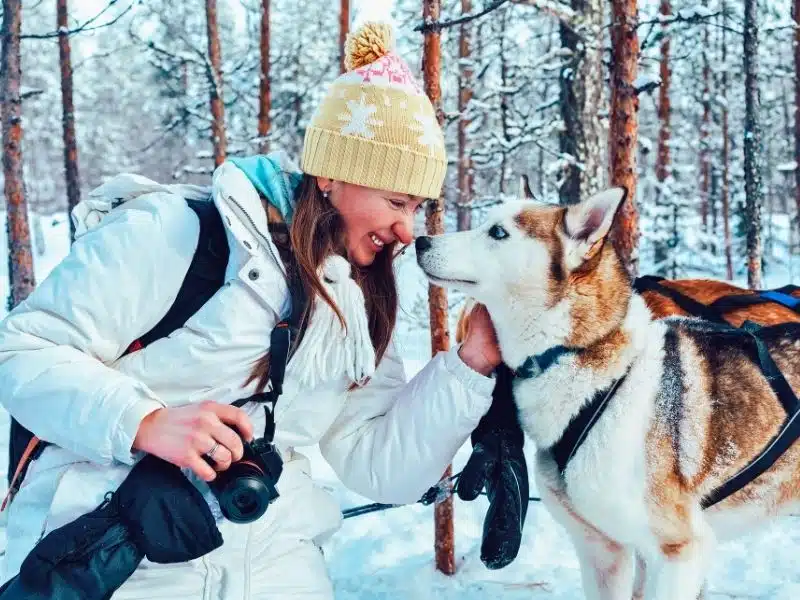
One Week Winter Capsule Wardrobe for Europe
This 7-day winter packing list is built around mix-and-match outfits, efficient layering, and cold weather fashion that works across western, central, southern, and even Eastern Europe. It also includes tech, toiletries, and travel documents so you can pack once and not stress.
Our packing list assumes you’ll re-wear items, layer strategically, and possibly do light laundry, as most travellers do on week-long trips. It’s designed to fit in a carry-on suitcase using packing cubes plus a personal bag or daysack.
Clothing
Outerwear
Tops
Base Layers
Bottoms
Underwear & Sleepwear:
Footwear
Accessories (All travel-friendly)
Toiletries (Travel-size and compact)
Tech & Documents
Optional Extras
January in Europe
Western Europe
January in western Europe is cold, wet, and unpredictable. Expect grey skies in London, wind in Amsterdam, and icy pavements in Paris. Temperatures usually stay between 1–7°C (34–45°F), but windchill makes it feel colder. Europe January outfits here need to be windproof, warm, and comfortable for long sightseeing days.
Go for layers you can adjust indoors: a soft thermal base, high-neck jumper, and a long wool coat. Travel fashion winter looks work best when they’re warm but polished; skip the bulky ski wear and instead rely on good fabrics. For your airport outfit winter combination, go with wide-leg and stretchy travel pants, sneakers or pull-on boots, and a beanie you can stash easily.
What to Pack for Western Europe in January:

Southern Europe
The Mediterranean might look sunny on Instagram, but southern Europe in January can be cold, especially inland. Expect 8–15°C (46–59°F) in Seville, Valencia, or Palermo. There’s less snow, but plenty of chilly mornings and damp evenings. You’ll still need layers, especially indoors, where heating can be minimal.
A winter travel outfit for here could be straight-leg trousers, a fine-knit jumper, and a cropped wool jacket. Focus on transitional pieces you can dress up or down. For airplane travel outfits heading here, wear your bulkier shoes to save space, and carry a wrap or scarf for unpredictable cabin temps.
What to Pack for Southern Europe in January:

Eastern Europe
January is the coldest month in most of eastern Europe, with temperatures frequently dropping below -5°C (23°F), and daytime highs hovering just below freezing. Snow is common, and streets get icy. Winter travel style here must be about insulation: you’ll need serious outerwear and cold-weather fashion that holds up in real winter, not just chilly weather.
Go for a down coat, snow boots, and plenty of layers. For a sightseeing outfit winter choice, insulated boots are non-negotiable, and trousers should be either fleece-lined or worn over thermals. For your airplane outfit, layer up even before you land – it’ll be cold the moment you leave arrivals.
What to Pack for Eastern Europe in January:
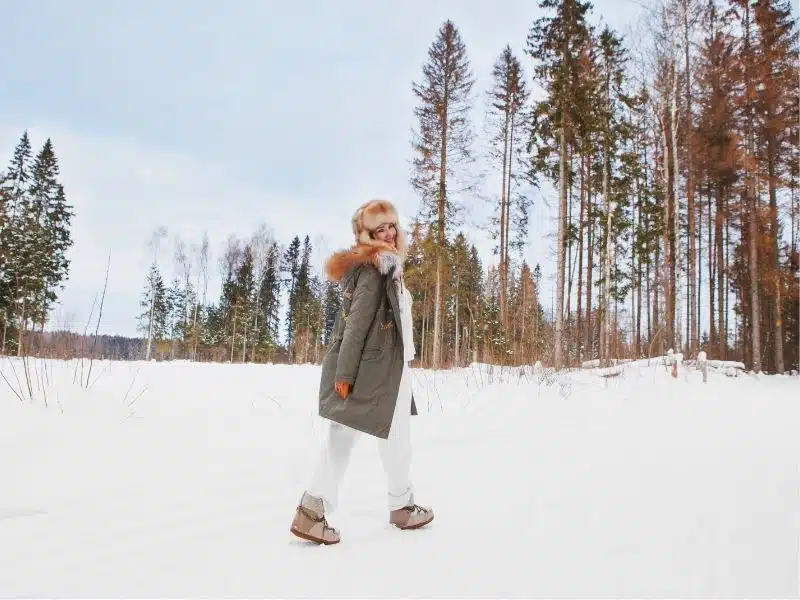
Central Europe
Germany, Czechia, and northern Italy often see snow in January. Temperatures sit around -4 to 4°C (25–39°F), and cities like Salzburg, Vienna, and Lucerne are icy, but beautiful. You’ll want structured outfits that can go from café to opera house but still keep you warm in the street.
Europe January outfits here should blend fashion and function: wide-leg trousers, smart wool coats, and boots that can handle cobbled streets. A good winter holiday outfit travel tip is to pack a thermal dress or jumper dress with leggings for a stylish but warm evening option.
What to Pack for Central Europe in January:
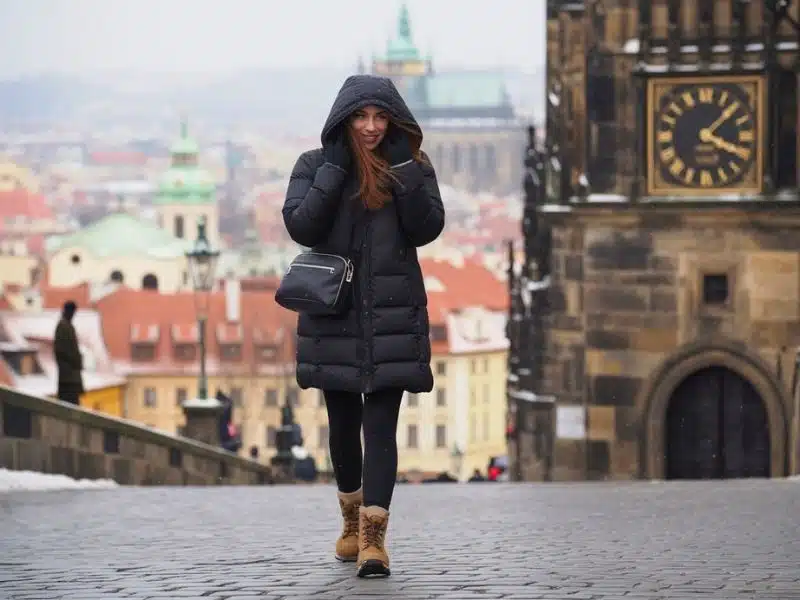
Scandinavia
Scandinavia in January is cold, dark, and often snowy. Temperatures average between -6°C and -2°C (21–28°F), but inland and northern areas can be much colder. Pack seriously warm gear: even urban exploring in Copenhagen or Stockholm can feel arctic in the wind.
For winter travel outfit planning, think layers under a heavy parka, waterproof boots, and merino wool everything. A chic airport outfit can still work: thermal leggings, a soft pullover, and a longline padded vest to stay warm from the terminal to the train station.
What to Pack for Scandinavia in January:
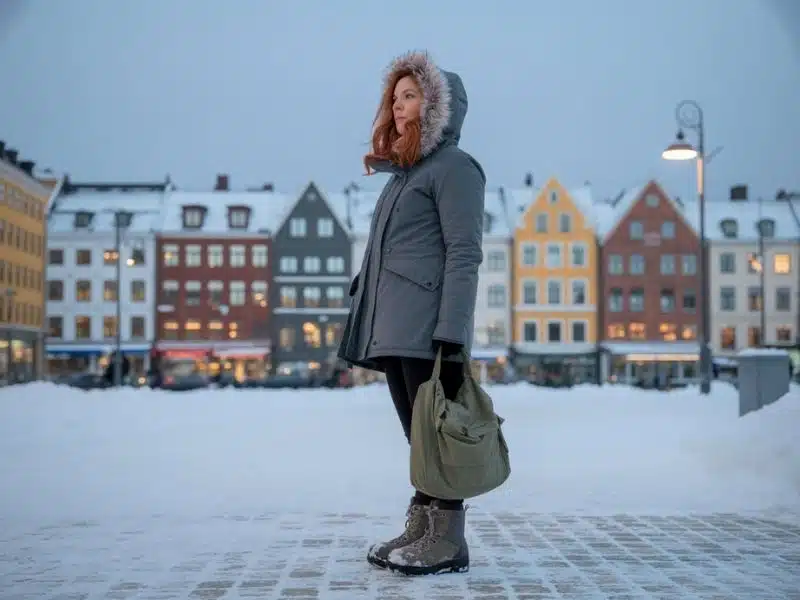
Winter Vacation Ideas
February in Europe
Western Europe
February begins to show faint signs of spring, but don’t be fooled – it’s still cold and often wetter than January. London, Paris, and Amsterdam average 2–8°C (36–46°F), with wind chill and rain making it feel colder. Winter travel style here is all about the trench coat–plus-layers combo.
Keep wearing your wool coats and knitwear, but you can start mixing in lighter colours or ankle-length coats that work for day and night. Airport outfit comfy doesn’t have to mean boring: try wide-leg trousers, platform sneakers, and a structured coat with a pop of colour.
What to Pack for Western Europe in February:

Southern Europe
February here feels more like late autumn. Places like Athens, Sicily, and Lisbon hover around 10–17°C (50–62°F), and sunny days are common. You’ll want a lighter wardrobe with layers you can easily take on and off.
Stick to travel wear that looks smart but handles changing temperatures. A midi dress with a leather jacket, wide-leg trousers with a tucked-in knit, and clean white sneakers all work well. For airplane travel outfits, go for breathable trousers, a light jumper, and a compact jacket you can wear on arrival.
What to Pack for Southern Europe in February:

Eastern Europe
It’s still full winter here, though slightly warmer than January. Temperatures generally sit between -2°C and 6°C (28–43°F), and slushy snow is common. You’ll still need heavy-duty cold weather fashion, but you can start playing with more colour or shape in your layers.
Go for sleek insulated coats, tall boots, and layers with personality. Your winter packing should still include base layers, warm accessories, and water-resistant shoes for navigating icy streets.
What to Pack for Eastern Europe in February:

Central Europe
Carnival season brings some sparkle, but February in central Europe remains cold, especially at night. You’ll want winter outfits that are warm enough for outdoor parades or late-night strolls, but that can also pass in stylish city centres.
Sightseeing outfit winter combinations could include dark jeans, a smart overcoat, and ankle boots with thick socks. A thermal dress with leggings makes a good dinner outfit. For chic airport outfit vibes, try ribbed knit trousers, a longline coat, and a scarf in a bold print.
What to Pack for Central Europe in February:
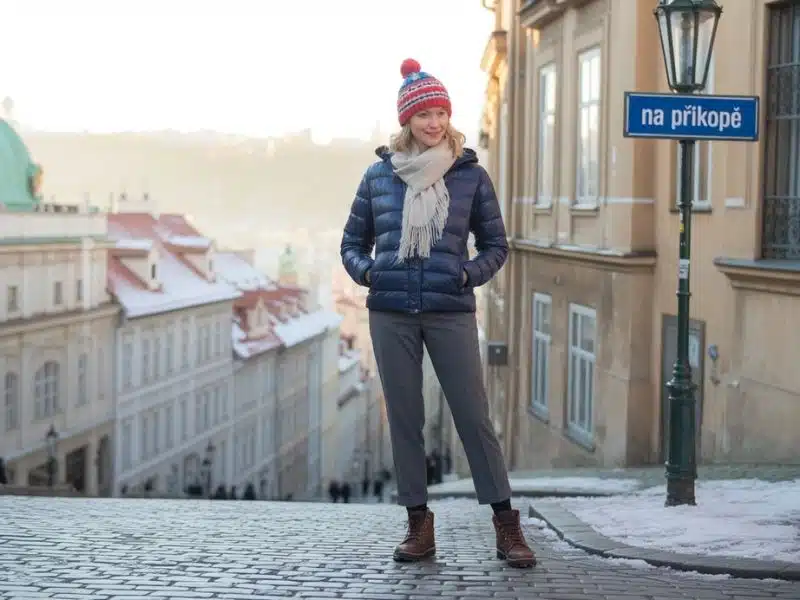
Scandinavia
Still very cold, but the light begins to return. Expect -4°C to 2°C (25–36°F) in Oslo, Stockholm, and Helsinki, with lingering snow and icy conditions. Winter travel outfits here are nearly identical to January, but you can start to mix in lighter shades or more playful accessories.
Capsule wardrobe options should still centre around warmth: base layers, snow boots, and puffer jackets. A sightseeing outfit could mean fleece-lined trousers, a fair-isle knit, and serious outerwear.
What to Pack for Scandinavia in February:

Styling Tips for Winter Travel in Europe
Packing for cold weather doesn’t mean dressing like a snowman. Here’s how to keep it stylish, practical, and low-effort:
Layer smart, not bulky: Stick to slim-fitting thermals and build up with natural fibres like wool or cashmere. A well-fitted base layer under a soft knit works better than three baggy sweatshirts.
Keep your palette cohesive: Stick to neutral tones with 1–2 accent colours. This makes mixing and matching effortless and keeps your outfits looking put together.
Boots matter: Choose a pair of boots that are warm, weatherproof, and broken-in. They’ll carry you through snow, cobbles, and airport security.
Invest in accessories: A great scarf or hat elevates the simplest look. Plus, accessories are small, light, and make every outfit feel fresh.
Airport style winter approach: Go for layers you can remove easily. Think oversized scarves that double as blankets and shoes you can slip off at security.
Europe January outfits work across all cold months: Once you’ve got your January looks locked in, they’ll take you through February too, especially in colder regions.
Looking for more European travel inspiration? Check out these top posts…
16 of the Best Travel Destinations in January
Our 60 Before 60 Travel Bucket List
The 16 Best Second Cities in Europe You Shouldn’t Miss
Adventure Travel Bucket List: 15 Epic Experiences in Europe
Travel Trends 2026: The Year of Mindful Escapes and Meaningful Journeys
The Ultimate Europe Travel Bucket List: 15 Classic Experiences to Inspire Your Next Trip
Love it? Pin it!
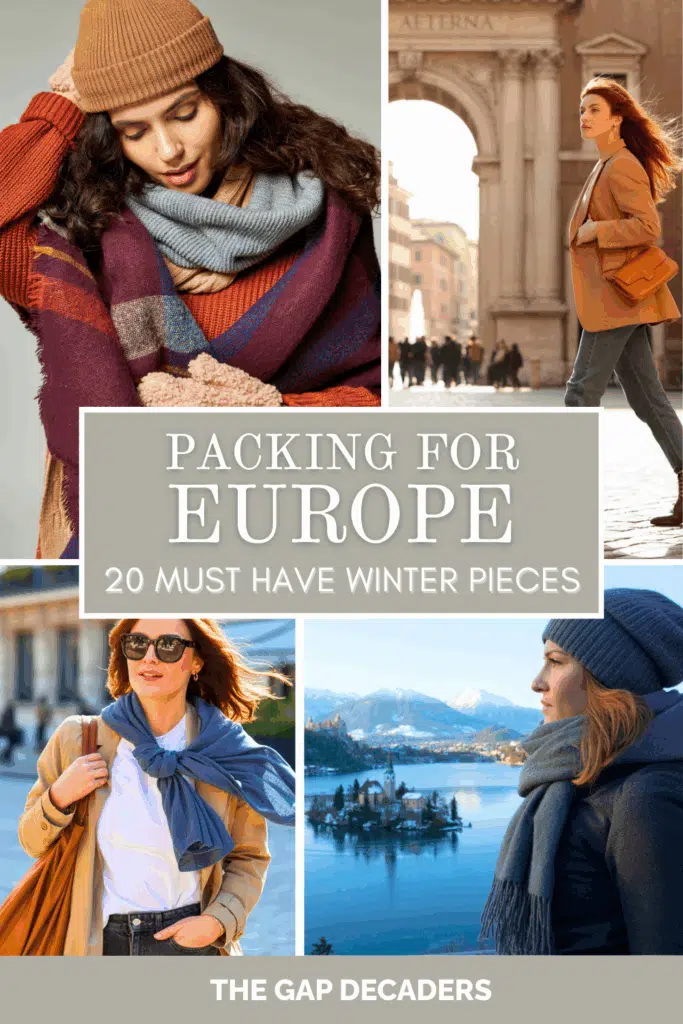










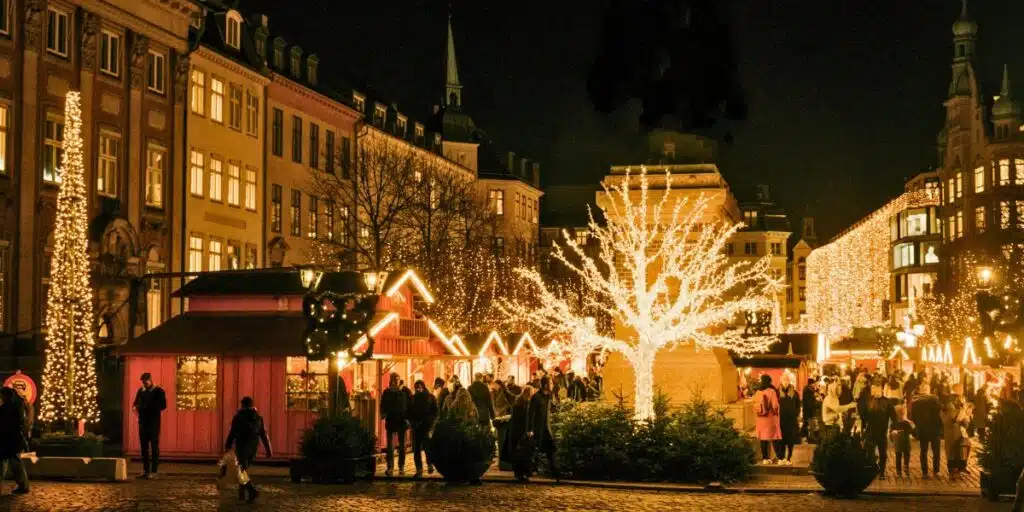








Hi Nora I would say comfortable and waterproof, which could be a pair of Gortex trainers for example. Hope that helps 🙂
gotta agree with TravelBug77 here. if you’re going places with a lot of snow or rain, waterproof is the way to go. but don’t forget to check they’re comfy too, cos nothing worse than blisters when ur tryna enjoy ur trip.
Nora, I had the same question! Last winter I went with waterproof boots that had good insulation. Total game-changer for me. Walking around all day, my feet stayed dry and warm. Definitely recommend looking for something with those features!
hey Izzy Nicholls, loving this guide but I got a question about the footwear section for the One Week Winter Capsule Wardrobe. you mentioned travel-friendly shoes, but what exactly does that mean for snowy places? are we talking waterproof or just comfy for walking? planning to do a lot of sightseeing and don’t wanna end up with soaked feet, lol.